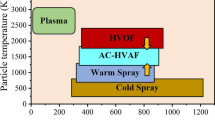Abstract
Investigation was performed of the effect of an external electric field on the completeness of combustion of ASD-1 aluminum powder in an airflow and on the disperse composition of condensed combustion products. It is established that for an oxidizer-to-fuel ratio of 0.8 and a combustor inlet flow rate of 10 m/sec, the application of an electric field increases the completeness of aluminum combustion from 43 to 75%. In this case, the sizes of submicron particles of aluminum oxide practically do not change, and the mass average sizes and the mass concentration of the 4 – 50 μm fraction decrease, due to the activating effect of the electric field on the vapor-phase combustion of aluminum particles. A decrease of the mass concentration of the size fraction larger than 50 μm from 12 to 3% under the action of the electric field suppress markedly the agglomeration of aluminum particles during combustion in air. Key words: aluminum, turbulent combustion, electric field, disperse composition of condensed products of combustion.
Similar content being viewed by others
REFERENCES
D. A. Yagodnikov and A. V. Vorenteskii, “Effect of the external electric field on the combustion of suspension of aluminum particles in air," Combust. Expl. Shock Waves, 34, No. 6, 621–626 (1998).
A. N. Zaidel', Measurement Errors of Physical Quantities [in Russian], Nauka, Leningrad (1985).
L. N. Stesik, E. I. Gusachenko, V. P. Fursov, et al., “Formation of agglomerates in combustion of composites," in: Physics of Air-Disperse Systems (collected scientific papers) [in Russian], No. 21, Vysshaya Shkola, Odessa-Kiev (1982), pp. 62–66.
E. I. Gusachenko, L. N. Stesik, V. P. Fursov, and V. I. Shevtsov, “Investigation of condensed combustion products of magnesium powders. I. Dependence on pressure," Combust. Expl. Shock Waves, 10, No. 4, 476–482 (1974).
A. N. Zolotko, Ya. V. Vovchuk, N. I. Poletaev, et al., “Synthesis of nanooxides in two-phase laminar flows," Combust. Expl. Shock Waves, 32, No. 3, 24–33 (1996).
V. A. Babuk and M. S. Malakhov, “Mechanism of formation of ultrafine aluminum oxide in combustion of aluminum particles," in: Intrachamber Processes, Combustion, and Gas Dynamics of Disperse Systems [in Russian], St. Petersburg (1997), pp. 147–150.
V. M. Kudrayvtsev, A. V. Sukhov, A. V. Voronetskiii, and A. P. Shpara, “High-pressure combustion of metals (three-zone model)," Combust. Expl. Shock Waves, 15, No. 6. 731–736 (1979).
V. M. Gremyachkin, A. G. Istratov, and O. I. Leipuhskii, “On the theory of combustion of metal particles," in: Physical Processes in Combustion and Explosion [in Russian], Atomizdat, Moscow (1980), pp. 4–68.
J. Lawton and F. Weinberg, Electrical Aspects of Combustion, Clarendon, Oxford (1969).
Author information
Authors and Affiliations
Rights and permissions
About this article
Cite this article
Yagodnikov, D.A., Gusachenko, E.I. Effect of an External Electric Field on the Disperse Composition of Condensed Products of Aluminum Particle Combustion in Air. Combustion, Explosion, and Shock Waves 38, 449–455 (2002). https://doi.org/10.1023/A:1016215416889
Issue Date:
DOI: https://doi.org/10.1023/A:1016215416889



